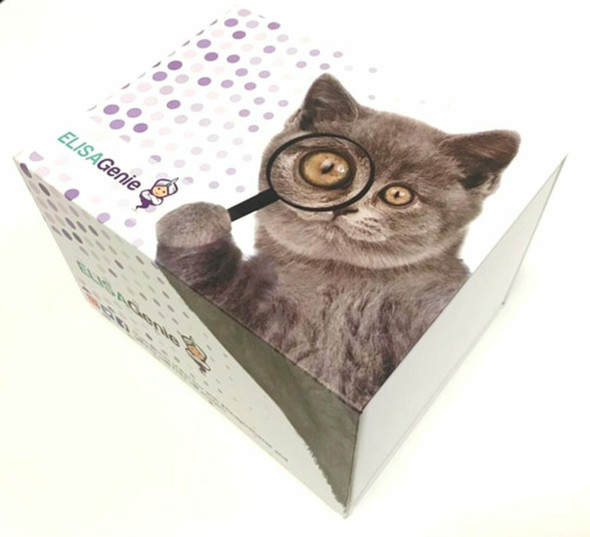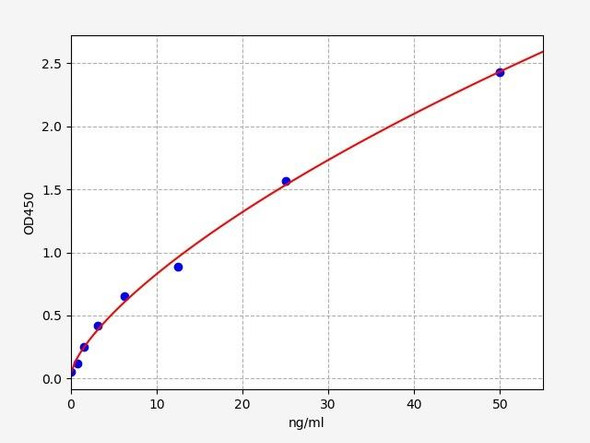Description
Human TMPRSS6 (Transmembrane Protease, Serine 6) ELISA Kit
The Human TMPRSS6 (Transmembrane Protease Serine 6) ELISA Kit is a powerful tool for the accurate quantification of TMPRSS6 levels in human samples. This kit boasts high sensitivity and specificity, guaranteeing precise and consistent results for various research applications. TMPRSS6 is a key enzyme involved in iron homeostasis and regulation of hepcidin levels. Dysregulation of TMPRSS6 has been linked to iron deficiency anemia and hereditary hemochromatosis, making it a crucial biomarker for studying these conditions and developing targeted therapies.
With its easy-to-use protocol and reliable performance, the Human TMPRSS6 ELISA Kit from Assay Genie is an essential resource for researchers exploring the role of TMPRSS6 in health and disease.
| Assay type: | Sandwich |
| Format: | 96T |
| Assay time: | 4.5h |
| Reactivity: | Human |
| Detection Method: | Colormetric |
| Detection Range: | 0.31-20 ng/mL |
| Sensitivity: | 0.19 ng/mL |
| Sample Volume Required Per Well: | 100µL |
| Sample Type: | Serum, plasma and other biological fluids |
| Specificity: | This kit recognizes Human TMPRSS6 in samples. No significant cross-reactivity or interference between Human TMPRSS6 and analogues was observed. |
This ELISA kit uses Sandwich-ELISA as the method. The micro ELISA plate provided in this kit has been pre-coated with an antibody specific to Human TMPRSS6. Standards or samples are added to the appropriate micro ELISA plate wells and combined with the specific antibody. Then a biotinylated detection antibody specific for Human TMPRSS6 and Avidin-Horseradish Peroxidase (HRP) conjugate are added to each micro plate well successively and incubated. Free components are washed away. The substrate solution is added to each well. Only those wells that contain Human TMPRSS6, biotinylated detection antibody and Avidin-HRP conjugate will appear blue in color. The enzyme-substrate reaction is terminated by adding Stop Solution and the color turns yellow. The optical density (OD) is measured spectrophotometrically at a wavelength of 450 nm ± 2 nm. The OD value is proportional to the concentration of Human TMPRSS6. The concentration of Human TMPRSS6 in samples can be calculated by comparing the OD of the samples to the standard curve.
| UniProt Protein Function: | TMPRSS6: Serine protease which hydrolyzes a range of proteins including type I collagen, fibronectin and fibrinogen. Can also activate urokinase-type plasminogen activator with low efficiency. May play a specialized role in matrix remodeling processes in liver. Plays a role in the regulation of iron homeostasis, a process involving HAMP. Required to sense iron deficiency and suppress activation of the HAMP promoter. Defects in TMPRSS6 are the cause of iron-refractory iron deficiency anemia (IRIDA); also known as hypochromic microcytic anemia with defect in iron metabolism or hereditary iron-handling disorder or pseudo-iron-deficiency anemia. Key features include congenital hypochromic microcytic anemia, very low mean corpuscular erythrocyte volume, low transferrin saturation, abnormal iron absorption characterized by no hematologic improvement following treatment with oral iron, and abnormal iron utilization characterized by a sluggish, incomplete response to parenteral iron. Mutations leading to abrogation of TMPRSS6 activity are associated with IRIDA due to elevated levels of hepcidin, a negative regulator of plasma iron pool (PubMed:20232450). Belongs to the peptidase S1 family. 4 isoforms of the human protein are produced by alternative splicing. |
| UniProt Protein Details: | Protein type:Membrane protein, integral; EC 3. 4. 21. -; Protease Chromosomal Location of Human Ortholog: 22q12. 3 Cellular Component: extracellular space; integral to membrane; plasma membrane Molecular Function:protein binding; serine-type endopeptidase activity Biological Process: cellular iron ion homeostasis; fibrinolysis; iron ion homeostasis; membrane protein proteolysis; negative regulation of transcription from RNA polymerase II promoter; negative regulation of transcription, DNA-dependent; positive regulation of transcription from RNA polymerase II promoter; proteolysis Disease: Iron-refractory Iron Deficiency Anemia |
| NCBI Summary: | The protein encoded by this gene is a type II transmembrane serine proteinase that is found attached to the cell surface. The encoded protein may be involved in matrix remodeling processes in the liver. Alternative splicing results in multiple transcript variants. [provided by RefSeq, Jan 2014] |
| UniProt Code: | Q8IU80 |
| NCBI GenInfo Identifier: | 209572718 |
| NCBI Gene ID: | 164656 |
| NCBI Accession: | Q8IU80. 3 |
| UniProt Secondary Accession: | Q8IU80,Q5TI06, Q6ICC2, Q6UXD8, Q8IUE2, Q8IXV8, B0QYB4 B0QYB7, B0QYB8, |
| UniProt Related Accession: | Q8IU80 |
| Molecular Weight: | 91,333 Da |
| NCBI Full Name: | Transmembrane protease serine 6 |
| NCBI Synonym Full Names: | transmembrane protease, serine 6 |
| NCBI Official Symbol: | TMPRSS6 |
| NCBI Official Synonym Symbols: | IRIDA |
| NCBI Protein Information: | transmembrane protease serine 6 |
| UniProt Protein Name: | Transmembrane protease serine 6 |
| UniProt Synonym Protein Names: | Matriptase-2 |
| Protein Family: | Transmembrane protease serine |
| UniProt Gene Name: | TMPRSS6 |
| UniProt Entry Name: | TMPS6_HUMAN |
As the OD values of the standard curve may vary according to the conditions of the actual assay performance (e. g. operator, pipetting technique, washing technique or temperature effects), the operator should establish a standard curve for each test. Typical standard curve and data is provided below for reference only.
| Concentration (ng/mL) | O.D | Average | Corrected |
| 20 | 2.371 2.431 | 2.401 | 2.33 |
| 10 | 1.572 1.59 | 1.581 | 1.51 |
| 5 | 0.907 0.887 | 0.897 | 0.826 |
| 2.5 | 0.468 0.478 | 0.473 | 0.402 |
| 1.25 | 0.254 0.232 | 0.243 | 0.172 |
| 0.63 | 0.171 0.171 | 0.171 | 0.1 |
| 0.31 | 0.119 0.125 | 0.122 | 0.051 |
| 0 | 0.068 0.074 | 0.071 | -- |
Precision
Intra-assay Precision (Precision within an assay): 3 samples with low, mid range and high level Human TMPRSS6 were tested 20 times on one plate, respectively.
Inter-assay Precision (Precision between assays): 3 samples with low, mid range and high level Human TMPRSS6 were tested on 3 different plates, 20 replicates in each plate.
| Intra-assay Precision | Inter-assay Precision | |||||
| Sample | 1 | 2 | 3 | 1 | 2 | 3 |
| n | 20 | 20 | 20 | 20 | 20 | 20 |
| Mean (ng/mL) | 0.97 | 2.55 | 7.36 | 0.94 | 2.32 | 6.97 |
| Standard deviation | 0.06 | 0.14 | 0.27 | 0.07 | 0.12 | 0.32 |
| C V (%) | 6.19 | 5.49 | 3.67 | 7.45 | 5.17 | 4.59 |
Recovery
The recovery of Human TMPRSS6 spiked at three different levels in samples throughout the range of the assay was evaluated in various matrices.
| Sample Type | Range (%) | Average Recovery (%) |
| Serum (n=5) | 85-97 | 92 |
| EDTA plasma (n=5) | 83-95 | 90 |
| Cell culture media (n=5) | 92-106 | 99 |
Linearity
Samples were spiked with high concentrations of Human TMPRSS6 and diluted with Reference Standard & Sample Diluent to produce samples with values within the range of the assay.
| Serum (n=5) | EDTA plasma (n=5) | Cell culture media (n=5) | ||
| 1:2 | Range (%) | 96-110 | 94-109 | 84-99 |
| Average (%) | 103 | 102 | 91 | |
| 1:4 | Range (%) | 92-107 | 86-99 | 87-103 |
| Average (%) | 99 | 91 | 94 | |
| 1:8 | Range (%) | 93-108 | 83-95 | 87-97 |
| Average (%) | 99 | 89 | 92 | |
| 1:16 | Range (%) | 86-100 | 82-95 | 84-96 |
| Average (%) | 92 | 87 | 90 |
An unopened kit can be stored at 4°C for 1 month. If the kit is not used within 1 month, store the items separately according to the following conditions once the kit is received.
| Item | Specifications | Storage |
| Micro ELISA Plate(Dismountable) | 8 wells ×12 strips | -20°C, 6 months |
| Reference Standard | 2 vials | |
| Concentrated Biotinylated Detection Ab (100×) | 1 vial, 120 µL | |
| Concentrated HRP Conjugate (100×) | 1 vial, 120 µL | -20°C(shading light), 6 months |
| Reference Standard & Sample Diluent | 1 vial, 20 mL | 4°C, 6 months |
| Biotinylated Detection Ab Diluent | 1 vial, 14 mL | |
| HRP Conjugate Diluent | 1 vial, 14 mL | |
| Concentrated Wash Buffer (25×) | 1 vial, 30 mL | |
| Substrate Reagent | 1 vial, 10 mL | 4°C(shading light) |
| Stop Solution | 1 vial, 10 mL | 4°C |
| Plate Sealer | 5 pieces | |
| Product Description | 1 copy | |
| Certificate of Analysis | 1 copy |
- Set standard, test sample and control (zero) wells on the pre-coated plate and record theirpositions. It is recommended to measure each standard and sample in duplicate. Note: addall solutions to the bottom of the plate wells while avoiding contact with the well walls. Ensuresolutions do not foam when adding to the wells.
- Aliquot 100µl of standard solutions into the standard wells.
- Add 100µl of Sample / Standard dilution buffer into the control (zero) well.
- Add 100µl of properly diluted sample (serum, plasma, tissue homogenates and otherbiological fluids) into test sample wells.
- Cover the plate with the sealer provided in the kit and incubate for 90 min at 37°C.
- Aspirate the liquid from each well, do not wash. Immediately add 100µL of BiotinylatedDetection Ab working solution to each well. Cover the plate with a plate seal and gently mix. Incubate for 1 hour at 37°C.
- Aspirate or decant the solution from the plate and add 350µL of wash buffer to each welland incubate for 1-2 minutes at room temperature. Aspirate the solution from each well andclap the plate on absorbent filter paper to dry. Repeat this process 3 times. Note: a microplatewasher can be used in this step and other wash steps.
- Add 100µL of HRP Conjugate working solution to each well. Cover with a plate seal andincubate for 30 min at 37°C.
- Aspirate or decant the solution from each well. Repeat the wash process for five times asconducted in step 7.
- Add 90µL of Substrate Reagent to each well. Cover with a new plate seal and incubate forapproximately 15 min at 37°C. Protect the plate from light. Note: the reaction time can beshortened or extended according to the actual color change, but not by more than 30min.
- Add 50 µL of Stop Solution to each well. Note: Adding the stop solution should be done inthe same order as the substrate solution.
- Determine the optical density (OD value) of each well immediately with a microplate readerset at 450 nm.









